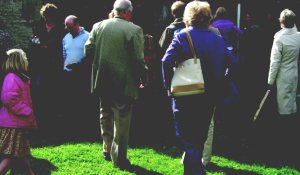
Beacon is different to other rural art initiatives in that, rather than taking art to the countryside, it takes the audience to the art. John Plowman explains
The first Beacon project took place over four consecutive weekends in September and October 2004. It consisted of a series of static and temporal interventions by seven artists at heritage sites in Lincoln and its rural surroundings. At each of these sites, the participating artists produced artwork that responded to a sense of the history of their particular location. An intrinsic aspect of this project was the 31D2 hour Beacon coach excursion that took the audience from site to site, enabling them to access these heritage sites through innovative visual art.
The idea of taking the audience to see art at heritage sites, has led to Beacon developing into an organisation whose mission is art ! travel ! site. Its aim is to establish new art and new artists in rural areas by programming a regular series of innovative visual art projects, establishing and consolidating an audience, locally, regionally and nationally, and raising the resources to support the programme of work.
Beacons 2005 programme, called Sense of place: place of sense, consisted of a series of commissioned temporary artworks at five heritage sites in Sleaford and its rural surroundings. Access to the art and heritage sites was facilitated by the Beacon coach excursion, leaving from the Sleaford Maltings each Saturday and Sunday at 9.30am and 2pm. The coach was also a site for a commissioned temporary artwork. Established artists were given an opportunity to platform new work whilst, simultaneously, emerging artists were supported in the development of their careers. The excursion lasted 31D2 hours and included a stop of 20 to 30 minutes at each of the sites.
Seats on the Beacon coach were free but had to be booked in advance, by phone or online through the project website. People were also offered the opportunity to reserve a reduced price baguette lunch at The Hub in Sleaford. A postcard was sent to confirm the booking of the coach and lunch (if applicable). Audience reaction was overwhelmingly positive. People appreciated the unique opportunity to see high-quality contemporary art in important heritage sites, and to share the experience of travelling through a little-known rural area.
A total of 775 people attended Beacon 2005, 25 fewer than the previous year. But there was less dependence on schools, and more adult visitors attracted through the projects increasingly effective marketing. Visitors came from as far away as London and Newcastle and the tracking of the secondary spend by Beacon visitors to Sleaford has highlighted the projects real potential as part of Lincolnshires cultural tourism strategy. The next stage will be to build on the established model by working in other parts of the county, in other ways and at other times of the year.
John Plowman is an artist and is Curator of Beacon. t: 01522 811809;
e: info@beaconartproject.com;
w: http://www.beaconartproject.com



